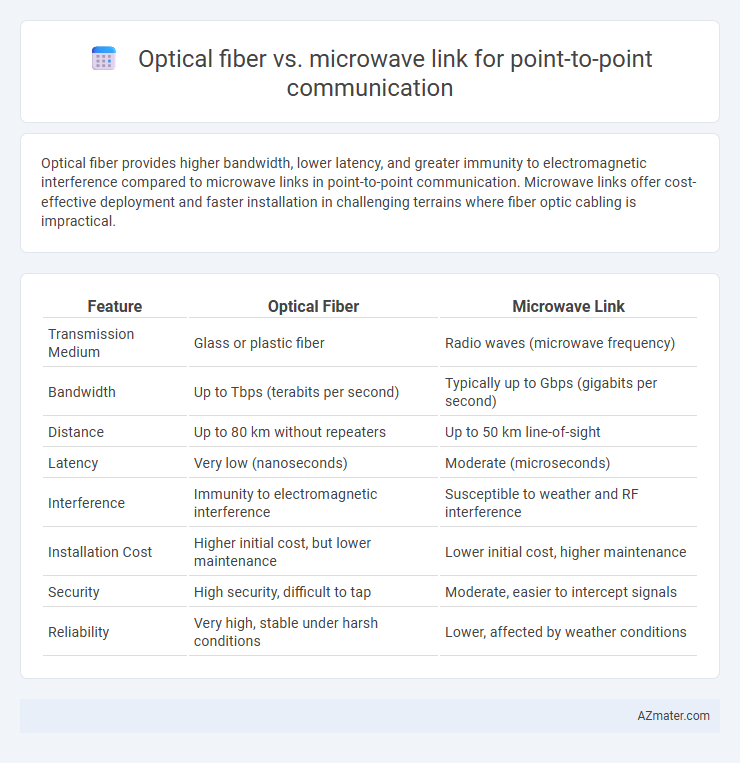Optical fiber provides higher bandwidth, lower latency, and greater immunity to electromagnetic interference compared to microwave links in point-to-point communication. Microwave links offer cost-effective deployment and faster installation in challenging terrains where fiber optic cabling is impractical.
Table of Comparison
| Feature | Optical Fiber | Microwave Link |
|---|---|---|
| Transmission Medium | Glass or plastic fiber | Radio waves (microwave frequency) |
| Bandwidth | Up to Tbps (terabits per second) | Typically up to Gbps (gigabits per second) |
| Distance | Up to 80 km without repeaters | Up to 50 km line-of-sight |
| Latency | Very low (nanoseconds) | Moderate (microseconds) |
| Interference | Immunity to electromagnetic interference | Susceptible to weather and RF interference |
| Installation Cost | Higher initial cost, but lower maintenance | Lower initial cost, higher maintenance |
| Security | High security, difficult to tap | Moderate, easier to intercept signals |
| Reliability | Very high, stable under harsh conditions | Lower, affected by weather conditions |
Introduction to Point-to-Point Communication Technologies
Point-to-point communication technologies enable direct data transmission between two locations, optimizing speed and reliability. Optical fiber offers high bandwidth, low attenuation, and immunity to electromagnetic interference, making it ideal for long-distance and high-capacity links. Microwave links provide flexible deployment with rapid installation and are effective in environments where laying fiber is impractical, although they face limitations like weather susceptibility and lower bandwidth compared to optical fiber.
Overview of Optical Fiber Communication
Optical fiber communication uses thin strands of glass or plastic to transmit data as light signals, offering high bandwidth and low signal attenuation over long distances. This technology supports faster data rates and immune to electromagnetic interference, making it ideal for high-capacity point-to-point links. Optical fibers provide enhanced security and reliability compared to microwave links, which can suffer from weather-related disruptions and limited frequency spectrum.
Overview of Microwave Link Communication
Microwave link communication utilizes high-frequency radio waves to transmit data wirelessly between two fixed locations, often offering reliable line-of-sight connectivity over long distances. This technology supports high data rates and is less expensive to deploy compared to optical fiber, especially in challenging terrains where laying fiber is impractical. Microwave links are widely used for telecommunications, broadcasting, and backhaul networks, providing scalable and flexible point-to-point communication solutions.
Bandwidth and Data Transmission Rates Comparison
Optical fiber offers significantly higher bandwidth and data transmission rates compared to microwave links, often exceeding terabits per second (Tbps) with minimal signal loss over long distances. Microwave links provide bandwidth typically in the range of gigahertz (GHz) frequencies, supporting data rates up to several gigabits per second (Gbps), but are more susceptible to atmospheric interference and distance limitations. The superior capacity and reliability of optical fiber make it the preferred choice for high-speed, long-distance point-to-point communication networks.
Signal Quality and Interference Resistance
Optical fiber offers superior signal quality with low attenuation and high bandwidth, enabling consistent data transmission over long distances without degradation. Microwave links are more susceptible to environmental factors such as rain, fog, and physical obstructions, causing signal attenuation and potential interference. Optical fiber's immunity to electromagnetic interference provides a more stable and reliable connection compared to microwave links, which face challenges from radio frequency interference and atmospheric disturbances.
Installation and Infrastructure Requirements
Optical fiber installation demands extensive trenching, duct placement, and careful cable handling to protect delicate glass strands, requiring significant groundwork and higher initial infrastructure costs. Microwave links utilize antennas mounted on towers or rooftops with clear line-of-sight, offering faster deployment and lower upfront civil works but depend on precise alignment and periodic maintenance. The choice impacts the total cost of ownership, with fiber providing higher bandwidth and durability versus microwave's flexibility in challenging terrains.
Cost Analysis: Optical Fiber vs Microwave Link
Optical fiber offers higher initial installation costs due to expenses in trenching, cable, and equipment but provides lower long-term maintenance costs and superior bandwidth capacity for point-to-point communication. Microwave links have lower upfront deployment costs and faster setup times but incur higher operational expenses related to line-of-sight maintenance and susceptibility to environmental interference. Overall, optical fiber presents a more cost-effective solution for high-capacity, long-term communication needs, while microwave links are financially viable for short-term or budget-restricted projects.
Security and Data Protection Aspects
Optical fiber offers superior security for point-to-point communication due to its resistance to electromagnetic interference and difficulty in tapping without detection, ensuring enhanced data protection. Microwave links, while faster to deploy, are more vulnerable to interception and signal jamming because they transmit data through the air, exposing transmissions to potential breaches. Implementing encryption protocols is critical for microwave systems to mitigate these security risks in high-sensitivity applications.
Scalability and Future-Proofing Considerations
Optical fiber offers superior scalability for point-to-point communication with virtually unlimited bandwidth capacity and minimal signal degradation over long distances, supporting future data rate increases without infrastructure overhaul. Microwave links face limitations in scalability due to spectrum congestion and susceptibility to environmental interference, constraining their ability to accommodate growing bandwidth demands. Investing in optical fiber infrastructure ensures future-proofing by enabling seamless upgrades to higher data transmission standards and integration with evolving network technologies.
Use Cases: When to Choose Optical Fiber or Microwave Link
Optical fiber is ideal for high-capacity, long-distance point-to-point communication requiring low latency and minimal interference, commonly used in urban telecommunications, data centers, and undersea cables. Microwave links are preferred for rapid deployment, cost-effectiveness, and connectivity in challenging terrains or remote areas where laying fiber is impractical, such as rural networks, emergency communications, and temporary event setups. Choosing optical fiber ensures superior bandwidth and stability, while microwave links offer flexibility and faster installation in less accessible regions.

Infographic: Optical fiber vs Microwave link for Point-to-point communication
 azmater.com
azmater.com